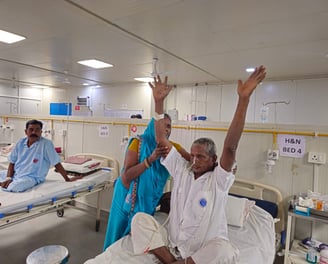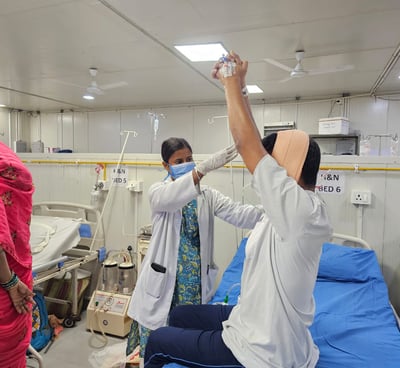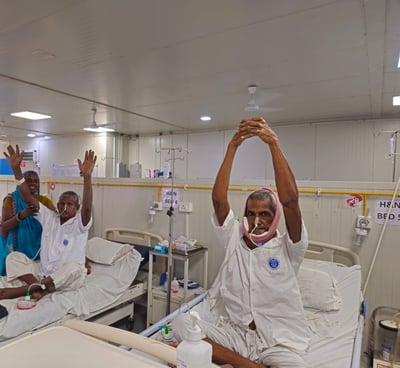Physiotherapy
AFTER SURGERY


Patients experience several side effects after head & neck cancer surgery – the severity, however, varies from one patient to another. Many of these side effects limit neck and shoulder movements and significantly lower the quality of life for patients. Therefore, it is imperative to ensure that the peatient undergoes physiotherapy after head and neck cancer surgery.

Shoulder and Neck Exercises
1. Neck Exercises
The doctor may recommend performing neck exercises 2-3 times per day. Each exercise should be done for at least five minutes.
Neck Rotation:
Lie on your back with a pillow supporting the head.
Move your neck sideways until you feel a maximum stretch on the opposite side.
Hold this position for 2-3 seconds, then move your neck to the other side and repeat.
Neck Side Flexions:
Lie on your back and tilt your head toward one shoulder so that your ear is near the shoulder.
Hold for 2-3 seconds, then return to the normal position.
Repeat the movement on the other side. You can use your hand to gently increase the stretch.
Neck Extension:
Sit straight and move your head backward.
Hold this position for 2-3 seconds, then return to normal.
Afterward, bend your head forward so that your chin approaches your chest.
2. Shoulder Exercises
These exercises help improve shoulder mobility.
Shoulder Circling:
Move your shoulders in a circular motion, lifting them upward and then moving them backward.
Squeezing the Shoulder Blade:
Sit straight with your hands extended to the sides.
Squeeze your shoulder blades together and hold for 5-6 seconds before relaxing.
Repeat this exercise.
Lifting of Arms:
Lie on your back with a pillow supporting your head.
Stretch your arms above your head with straight elbows.
Hold this position for a few seconds, then relax.
Shoulder Rolls and Shrugs:
Sit upright and lift your shoulders toward your ears.
Hold this position for 2-3 seconds, then relax.
Chest Physiotherapy
Chest physiotherapy plays a significant role in helping post-operative cancer patients by clearing mucus from the lungs and improving breathing.
To perform chest physiotherapy:
Percuss or clap over the back of the thorax (lungs area) on both sides.
Guide the patient to cough forcefully to remove mucus from the lungs.
Mouth Opening Exercises
Trismus, or reduced mouth opening, is a common complication after head and neck cancer surgery.
Exercises:
Open your mouth and move your chin to the left, right, and forward, holding each position for 5 seconds.
Open your mouth as wide as possible to improve mouth opening.
Use a jaw stretcher key to gently stretch your mouth. Hold the stretch for 30 seconds, then relax.
Repeat this exercise 5 times a day, with 5 repetitions per session.
Importance of Exercises
Rehabilitation exercises after head and neck cancer surgery are essential for:
Preventing stiffness and promoting quick recovery.
Reducing the risk of complications, such as blood clots.
Managing mental and physical distress, including anxiety, depression, and fatigue.
Supporting early mobilization, which helps patients regain independence in routine activities.
Exercising regularly after surgery can significantly enhance recovery and improve overall well-being.








